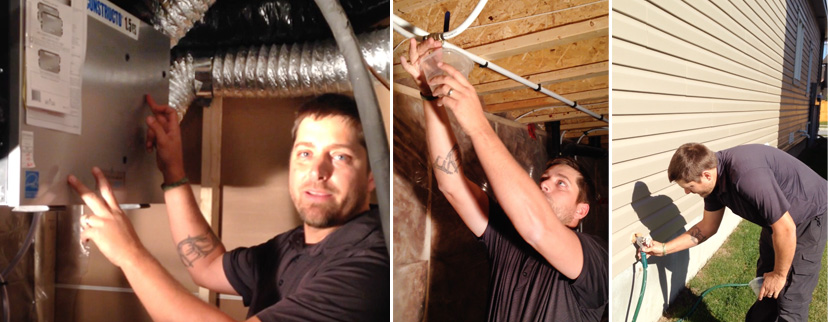It goes without saying that you need to respect your property in order for it to respect you. Upon your moving into a beautiful new home that meets your needs, it makes sense to ensure that it is kept in top condition throughout the seasons. This is especially important in Canada, where the weather can be dramatic in terms of temperatures, air moisture and inclement conditions. With proper care and diligence, it’s a breeze to prepare your new home for the ever-iconic Canadian winter. Here are our top maintenance tips for doing so.
Shut off Air Conditioner and Clean Air Filters
To ensure that your home isn’t inadvertently cooled during the winter, shut your air conditioner off either directly at the switch or breaker. With the system powered down, you can instead conserve energy for use in heating your home during the colder months. Also, be sure to clean and/or replace the air filters in your HRV, furnace and hood fan. Follow the recommended time of your specific filter, but should normally be done once a month to keep your air clean and efficiently filtered. You should also ensure that all outdoor air vents aren’t blocked.
Tutorial video on how to change an HRV filter
Dehumidifier and Thermostat Adjustments
It is a good preventative measure to adjust your dehumidifier so that it maintains the relative humidity (RH) below 50%. This will protect against dampness and moisture-related problems such as windows developing a film of condensation, which can occur in any home if the RH is too high and makes the air too moist. Also, try setting your thermostat to “heat” mode, and set the fan to the “on” setting to enable for more efficient air circulation throughout your home. Optimal temperature setting is generally around 24 Celsius.
Window Upkeep
Even if your home is brand new and you’ve only lived in it for a few months, it doesn’t hurt to give the screens, hardware and window glass a good cleaning. Try removing the screens from windows to enable for air to flow across the glass and therefore reduce the potential for condensation buildup. Additionally, it’s a good idea to check for air leakage. It’s very unlikely that you’ll have bad seals in a new home, but checking either way will ensure that your home is airtight for the winter, enabling for efficient temperature and humidity control. Also, be sure to remove leaves and debris from window wells so they can properly drain and ensure that your window latches are firmly locked.
Garden and Yard Preparation
It’s best to take care of prepping your garden and lawn for winter in the late fall. Prune your shrubbery and other plants, keeping branches and limbs at least 3 feet away from the house to ensure that moisture won’t drip and interact with it. This will also protect your new home from exterior damage during high winds. Additionally, be sure to protect delicate items with shroud covers. You should also take the time while outside to clear gutters of leaves and other blockages (you could even install heat cables in areas prone to ice buildup). For lawns, it’s best to apply lawn seed to dull patches in late August, followed by winter fertilizer. Afterwards, cut grass in drainage ditches and other areas intended for run-off to minimize damage to your yard throughout the winter and spring thaw.
Test Alarms and Get to Know Your Plumbing
When you’re in a new home, it’s good to familiarize yourself with its carbon monoxide and smoke alarms. Give these a test every month to ensure that they’re functioning properly, and be sure to replace batteries in units that use them every two months at least. Another important aspect of your home is the plumbing. Take the time to learn how your system works, and be sure to close the water valves for all outside hose bibs (located in the basement). Hose bibs should also be winterized before the first frost. Then, bleed the lines to protect against them freezing.
Tutorial video on how to drain hose bibs and prevent frozen pipes
Inspect Your Roof
In a new home this should be a quick and simple process with no worries afterwards, but regardless, it’s a good idea to check your roof for the wayward shingle and to ensure your flashing around chimneys and air vents is in good shape. Your attic should also be inspected for displaced insulation and blocked ventilation, as air must be able to move through the attic to keep your roof healthy.
Owning a new home is an exciting experience, and with these newfound joys come some basic responsibilities as a homeowner looking to protect their investment. Taking a little time this fall to give your property a lookover and make a few preventative adjustments will ensure that your new home remains safe, comfortable, efficiently heated and receives proper air circulation not just this fall and winter, but for years to come with proper maintenance and care.
Stay informed, sign up for the latest news
Sign up and learn in advance about special offers, new releases & exciting news in your chosen community!
[button_mini link=”/priority-registrant-list/”]Priority Registrant List[/button_mini]
